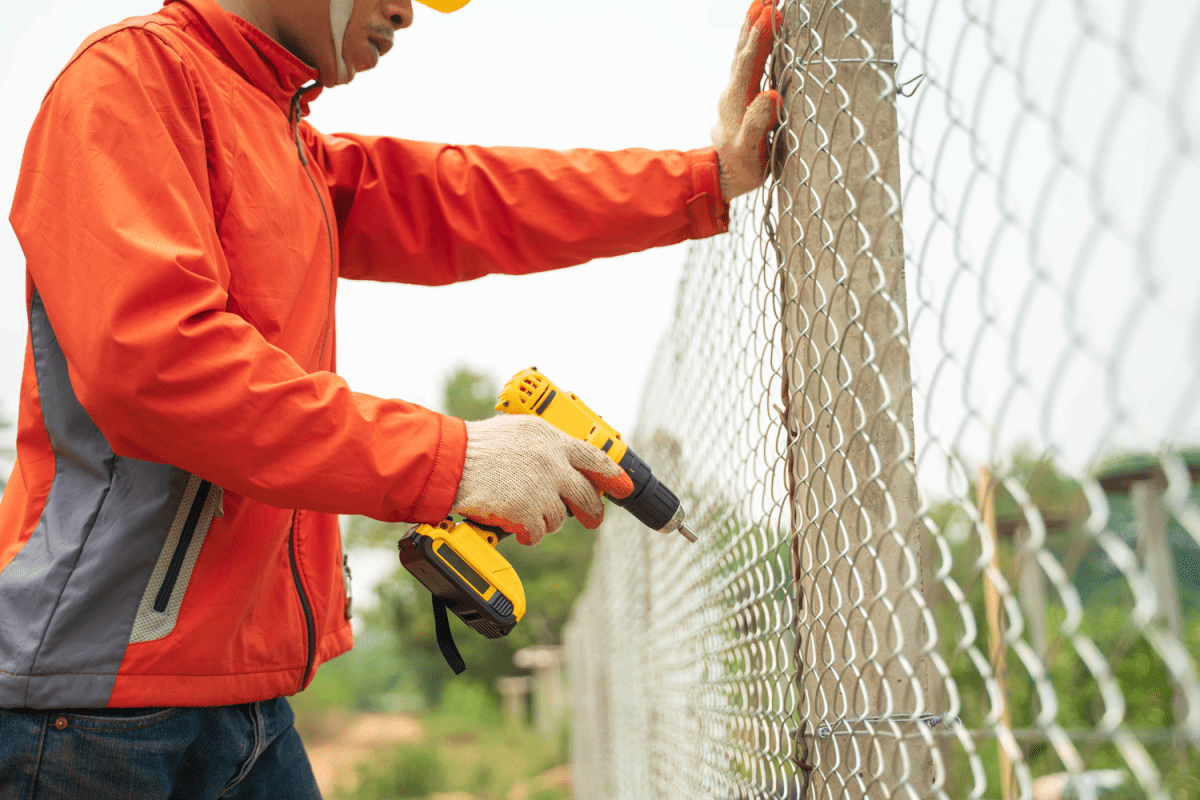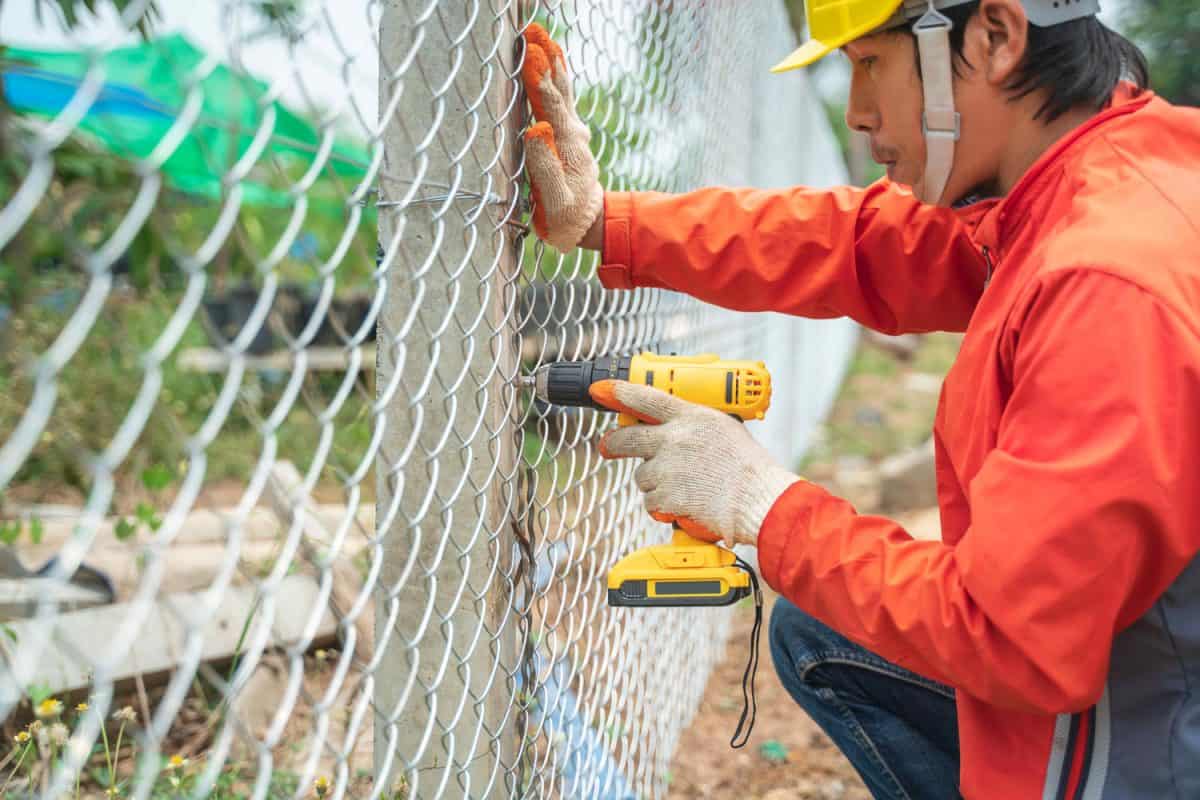Are you planning to install a chain-link fence in your yard, and you are torn about whether you should put concrete on your chain-link posts? Well, you don't have to worry about that anymore. We have conducted thorough research to know the answer to your question.
You can install chain link fences without utilizing concrete. However, we don't recommend doing this. The best approach to ensure that your fence stands firm and straight for many years is to anchor each fence post in concrete.
It would be best for you to keep reading if you want to know the details on why installing concrete on fence posts is a must. In addition, we might be able to answer some of the questions that are building up in your mind.

Securing Your Fence Posts By Anchoring It With Cement
Incorporating concrete anchors into them is not practical if you plan to have just temporary chain-link fences. In all other circumstances, anchoring each fence post is the most effective technique to stop years of tilting and shifting.
Some people recommend only putting cement at the end, corner posts, and gate, but this procedure can still permit movement, so you will have to reinstall the unanchored posts after a few years.
Consider the Soil Composition
If you install fence posts, consider what type of soil you will have to use. Knowing such will let you determine the stability of the ground.
Clay soil, for instance, between rainy and dry seasons, contrasts a lot and becomes more extensive. And this case causes the fence posts to shift and settle diversely. Additionally, clay soil will require concrete anchors.
On the other hand, if you have unusually sandy soil, you might be able to get away without incorporating concrete. However, to increase the stability of the fence posts and drainage around them, use a polymer backfill.
Installing Chain Link Fence Posts With Concrete

Installing a chain link fence post with concrete can take two full days to finish. That time already includes the time for the cement to dry.
The materials you will need for whether or not to install concrete on a chain-link fence are:
- fence posts
- gates
- post-hole digger
- tension wires and bars
- fasteners
- power auger
- shovel
- chain link mesh
- socket wrenches
- fence puller
- pipe cutter or hacksaw
- line level
- plumb bob
- gravel
- trowel
- pliers
- pre-mixed concrete
- mason's line
- rubber mallet
- pull bar
Step 1:
The size of the post hole varies depending on the geographical area, fencing materials, and fence height. But generally, you must dig a hole six inches in diameter by 30 inches deep. Another rule of thumb is to excavate the holes three times the diameter of the fence post.
Step 2:
Visually inspect the holes if they are all accurate. If the holes are shallow due to a stuck object, bell the hole at the bottom. And to bell, make the bottom of the hole wider than the top using a post-hole digger.
Step 3:
Mix a pre-mixed concrete with water. Mix it until it looks like thick gray mud, so you should go easy with the water.
Step 4:
Mark post grade mark. You should mark the gate, end, and corner posts at the height of the fence plus an inch. For example, 49 inches for a four-foot fence, and 61 inches for a five-foot fence. On the other hand, you should mark intermediate or line posts at the fence height minus three inches.
Step 5:
You will now have to adequately fill the holes with the cement mix. Filling too many at once will cause the concrete to cure before you can stick the posts.
You can install and stick the chain-link posts after you pour the cement into the hole. Simply place the post into the center of the hole in the cement mix. Another method for installing posts is to have one person hold the post plumb to the string line while another pours concrete mix around it.
Step 6:
After grading each post, backfill with dirt. Once you finish, step on the backfill to keep the dirt in place. Repeat this process for the rest of the fence post.
Step 7:
Stand at the end of the fence length to view the posts. You should look across the peaks of the posts. Adjust the posts if necessary. It would be best to ask another person to assist you to prevent sharp changes.
Step 8:
Install the gate posts. Follow the precise opening size advised by the gate manufacturer to install the gate posts.
Step 9:
Leave the concrete to dry for 24 hours before continuing.
Installing Chain Link Fence Posts Without Concrete

You can utilize a post-hole digger to dig a deep enough hole to bury your chain-link fences at least two feet. Or roughly one-third of the height of the chain-link fence to erect it without using concrete.
If you pound the posts into the ground, the tops will flex, especially if you have rocky soil or hard clay. So, it would be best to be careful in this process. In addition, the hole you will be making should be larger than the fence posts so that earth can be backfilled securely around the post.
Indeed, you can save a modest amount of money on the concrete, gravel, and trowel if you install your chain-link fence posts without concrete. And if you utilize the auger to excavate your post holes, there is a possibility that you can finish the installation in just a day.
Alternatively, if you don't want to spend a $50 rental fee on using an auger, you can dig holes by hand. However, that will take you much longer to excavate the area.
Check out this post hole digger on Amazon.
Why Setting Posts With Cement Is Important

If you plan to put up your fence, you may assume that simply burying the fence posts in the ground is already enough. Your fence would appear secure and stable on the surface, but in reality, it will not last long or withstand the elements.
In addition, depending on the kind of fence you have, it may endure a lot of wear and tear over time.
1. Concreting Posts Can Withstand Wind
When it comes to the longevity of your fence, the wind plays a significant role. Winds can drag and push the fence back and forth. And such a happening will cause the posts to lose if you can not adequately secure them with concrete.
2. Concreting Posts Can Withstand Shifting Ground
As the weather varies throughout the year, the ground shifts, too. These fluctuations can loosen the dirt surrounding your post, making your fence wiggle and unstable. So, setting them in concrete would be best if you want your chain-link fence posts to withstand the elements and the passage of time.
Type Of Concrete For Fence Posts

You have a few options when it comes to the cement you should use to place your fence posts. And they are:
1. Quick-Drying Concrete
This type of concrete is the most typical and straightforward to use. It is unnecessary to mix quick-drying concrete in a different container before utilizing it. You will have to pour it into the hole. After that, press your chain-link fence post down and control it in place for a few seconds until it sets.
In addition, if you want to finish the installation process in a few days, this concrete is also ideal.
Check out this quick-drying cement mix on Amazon.
2. Two-Part Concrete
You can opt to utilize a standard high-strength two-part concrete if you want your fence post to withstand anything. You will have to blend the concrete in a different container in its procedure.
It will also take longer for high-strength concrete to set. Although it will take too much of your time, it will give your fence posts a somewhat more solid grip.
However, make sure you start by filling your hole with gravel, regardless of the type of concrete you utilize.
As your chain-link fence ages, a good gravel base will keep its posts from sinking into the ground. Additionally, it is also an excellent idea to utilize an agitator when you pour concrete. Getting rid of all the air bubbles from the cement can increase its longevity and strength.
Amount Of Concrete For Chain Link Fence Posts

If we talk about the portion of cement that we need to set the fence posts, metal chain-link fences have their requirements. There are two types of posts in chain-link fences that require varying quantities of cement, and they are:
1. Terminal Post
A terminal post is the first type of chain-link fence post. These are the posts that connect chain-link fences over great distances. And these are commonly at corners, outside of gates, and any other endpoint.
A hole with an eight inches diameter and a depth of 30 inches to three feet is what we will require for a terminal post. And each of these holes needs at least 0.85 cubic feet to fill. Lastly, you should set each terminal post with three 50-pound bags of concrete.
2. Line Post
A line post is the other type of post that a chain-link fence requires. You can utilize this type of fence post between terminal posts to fasten the fence every few feet correctly. And because line posts support more diminutive of the fence's overall weight, they require less cement.
Line posts are of lesser diameter, and they need less burying depth. Plus, you should insert each line into a two feet deep, six inches wide hole.
Filling these holes should take about 0.4 cubic feet of concrete. And this equates to just over one 50 pounds bag of concrete. If you anticipate a lot of wear and tear on your metal chain-link fence, it's fine to dig your holes a little more in-depth.
Wrap It All Up
Now you already know that concreting chain-link fence posts is a must if you want the longevity and stability of your fence to increase. It would be best to follow all the guidelines we mentioned above for you to install your metal chain-link fences correctly.
Thanks for reading this post, and we hope you find it helpful. If you want more of our help, you are always free to browse our website, or you might want to check these out:





